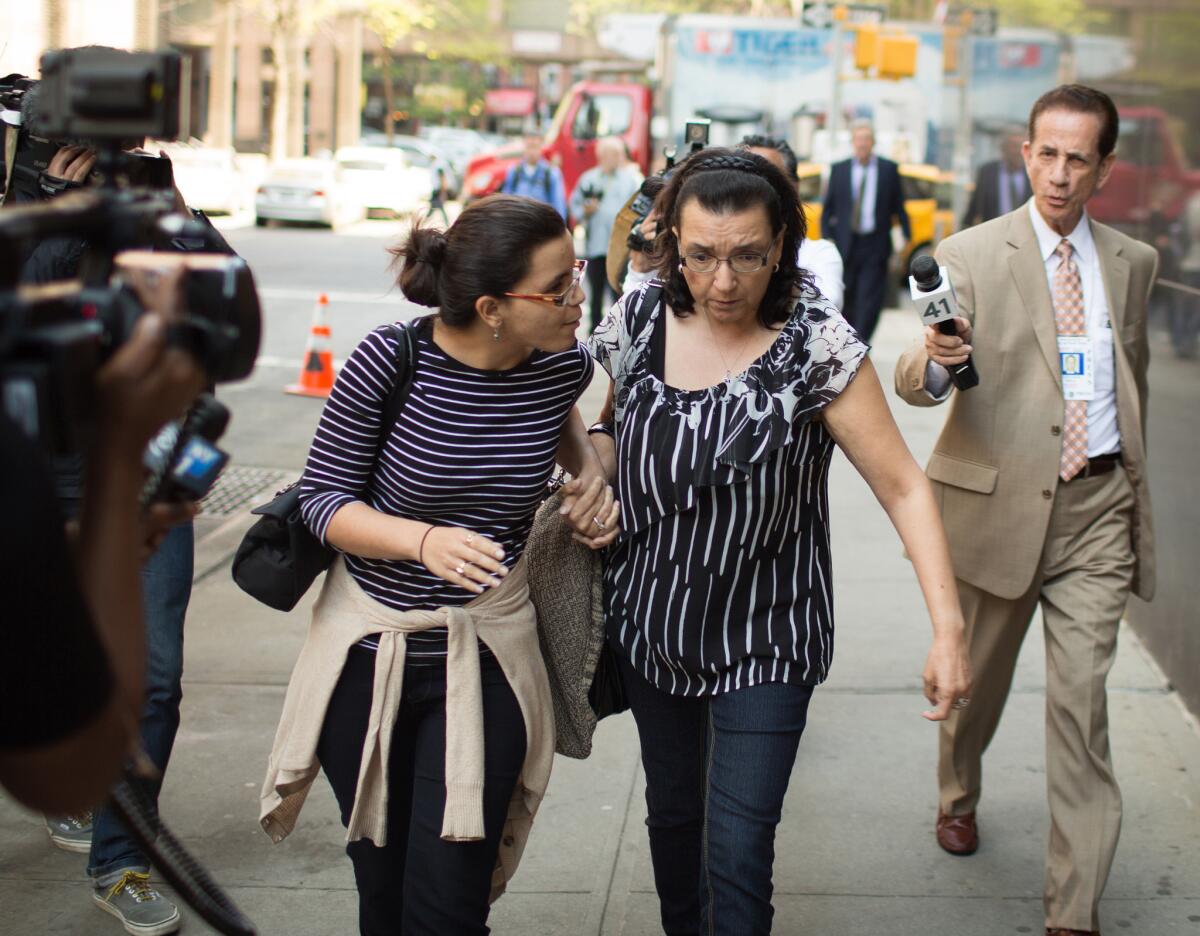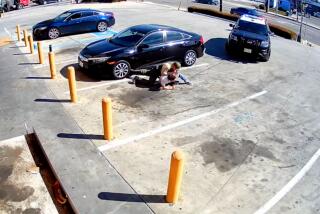Column: The hung jury in the Etan Patz case was right

Pedro Hernandez’s daughter, Becky Hernandez (left), holds hands with her mother, Rosemary Hernandez, as they exit court on May 8.
A judge in New York City declared a mistrial Friday in the case of Pedro Hernandez, a disabled factory worker charged in one of the most famous child abductions in modern memory: the disappearance of 6-year-old Etan Patz more than 30 years ago.
The jury was deadlocked, 11 to 1. The holdout, 42-year-old Adam Sirois, insisted there wasn’t sufficient evidence to convict Hernandez, whose history of schizophrenic delusions and hallucinations complicated his confession.
Sirois has since become a minor celebrity, giving interviews and, in one case, being compared to Henry Fonda’s character in the 1957 film “Twelve Angry Men,” a courtroom drama in which a single juror painstakingly persuades his fellow panelists to come over to his side and declare a man not guilty.
Sirois’ heroism isn’t quite so clear-cut. He’s been accused of courting the spotlight, flaunting his intelligence and generally appearing smug and self-satisfied. Another juror called him “totally irrational” and told a reporter, “We never want to see him again.”
Just as it’s possible to be guilty of a crime when there isn’t enough evidence for a conviction, it’s also possible to be both an arrogant jerk and absolutely correct. Sirois was right to not convict Hernandez. It’s one thing to crave the closure a guilty verdict would bring to a wrenching, brutal case. It’s quite another to convict the wrong guy because someone should pay.
Etan Patz disappeared from his Soho neighborhood on May 25, 1979, the first day his mother allowed him to walk two blocks to the school bus unaccompanied. The search for Etan, which never turned up a body, led to radical shifts in ideas about the innocence of childhood and the responsibilities of parenthood.
A culture that once saw little harm in mothers parking babies in strollers outside stores while they ducked inside transformed into one suffused with constant, low-grade child-safety anxiety, even in quiet suburbs.
Children who once played outdoors for hours without adult supervision were now sternly educated about “stranger danger,” ferried from one supervised activity to the next, or kept inside in front of televisions and video games. In 1983 President Reagan declared May 25 Missing Children’s Day, and Etan’s face was among the first to appear on the milk carton campaign of the 1980s.
In 2004, a convicted pedophile named Jose Ramos was judged responsible for Etan’s death in a civil lawsuit. Ramos, a drifter who in the late 1970s had lived for a while in a drainpipe in upper Manhattan, dated a woman who for a time had been hired by the Patzes and other families to walk their children to school during a school bus strike. Ramos told a prosecutor he was “90% sure” he’d met Etan on the day of his disappearance and tried to molest him before putting him on a subway.
Eight years later, Hernandez entered the picture based on a police tip. In 1979 he worked at a bodega near Etan’s bus stop where neighborhood children routinely gathered, As if in a bizarre game of grotesque one-upsmanship, Hernandez — whose lawyers say he has an IQ of around 70 and a history of delusions and hallucinations — told investigators he strangled Etan in the bodega’s basement, put the body in a plastic bag and took it out with the trash.
In today’s climate of helicopter parenting, and in an economy in which cities whose once-gritty neighborhoods brim with multimillion-dollar real estate and meticulously screened nannies, it is almost unimaginable that youngsters once roamed the streets alone and convened at will at bodegas. The idea that loving parents could entrust their children to someone who also cavorted with drainpipe-dwelling pedophiles seems like something out of a sick fairy tale.
Which is exactly why Sirois was right to vote against conviction.
Hernandez was the defendant, but what was also on trial was the memory of a bygone era, one about which it is possible to feel simultaneously nostalgic and horrified, a combination that bounces us between certainty and mystification about what could have happened in those days. The jury had to wrestle with slim facts, a generation’s worth of anxiety about real and mythical boogeymen and the degree to which parents can and cannot keep them away.
We may never know exactly what happened to Etan. And that’s even more terrifying than anything offered in these confessions. Given that, a mistrial, although deeply unsatisfying, seems strangely, and sadly, appropriate.
Twitter: @meghan_daum
Follow the Opinion section on Twitter @latimesopinion and Facebook
More to Read
A cure for the common opinion
Get thought-provoking perspectives with our weekly newsletter.
You may occasionally receive promotional content from the Los Angeles Times.






